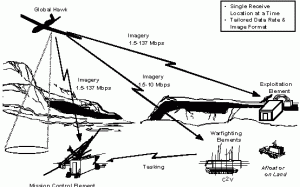RADIO FREQUENCY DATA BACKBONE TO MATCH FIBER OPTIC CAPACITY
-Defense Advanced Research Projects Agency
Fiber optic cables provide the core backbone for military and civilian networks, enabling Internet, phone, video and other data to move at super-high speeds with virtually no degradation over long distances. In deployed environments, where a fiber optic backbone doesn’t exist, other communications modes are used resulting in reduced data-rate capacity for the warfighter.
DARPA’s 100 Gb/s RF Backbone (100G) intends to develop a fiber-optic-equivalent communications backbone that can be deployed worldwide. The goal is to create a 100 Gb/s data link that achieves a range greater than 200 kilometers between airborne assets and a range greater than 100 kilometers between an airborne asset (at 60,000 feet) and the ground. The 100G program goal is to meet the weight and power metrics of the Common Data Link (CDL) deployed by Forces today for high-capacity data streaming from platforms.
In essence, DARPA wants to give deployed soldiers the same kind of connectivity as a high-bandwidth, low-latency fiber-optic network. In the case of Afghanistan, for example, the US might have a high-speed fiber link to Turkey — but the remaining 1,000 miles to Afghanistan most likely consists of low-bandwidth, high-latency links. It’s difficult (and potentially insecure) to control UAVs or send/receive intelligence over these networks, and so the US military instead builds its own wireless network using Common Data Link.

Common Data Link (CDL) is a secure wireless protocol that networks together a US military deployment, for shuttling to UAVs, aircraft carriers, helicopters, forward operating bases — they’re all connected together via wireless CDL links, bounced via high-altitude aircraft or orbiting satellites. Exact, up-to-date specs are hard to come by, but it seems like the US military’s existing CDL links max out at around 250Mbps. DARPA now wants to push these speeds up to 100Gbps, while using equipment that retains the same weight/power requirements of CDL — i.e. these 100G systems must be deployable in the field.
A major challenge to providing 100 Gb/s from an airborne asset to the ground is cloud cover. Free-space optical links won’t propagate through the cloud layer, which means RF is the only option. The system will be designed to provide all-weather capability enabling tactically relevant data throughput and link ranges through clouds, fog or rain. Technical advances in modulation of millimeter-wave frequencies open the door to achieving 100G’s goals.
“Providing fiber-optic-equivalent capacity on a radio frequency carrier will require spectrally efficient use of available RF spectrum,” said Dick Ridgway, DARPA program manager. “100G plans to demonstrate how high-order modulation and spatial multiplexing can be synergistically combined to achieve 100 Gigabits per second with the size, weight and power needed for a deployable system. We believe that to achieve the program’s goals requires the convergence of telecommunications system providers and the defense communications tech base.”
DARPA will host a proposers’ day on Jan. 9, 2013, in Arlington, Va. For details, visit:http://go.usa.gov/gVnB
While DARPA maintains that this will be a military only system, the commercial applications can be humongous. Wireless backhaul is a growing area globally as high speed data for smart phones and wireless media devices explode in growth.
source: http://www.darpa.mil/NewsEvents/Releases/2012/12/14.aspx

